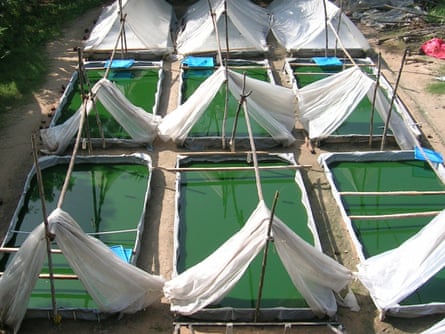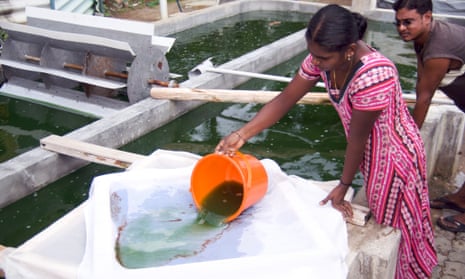Hailed by health obsessives as the superfood to conquer viruses, prevent ageing and even ward off cancer, spirulina may be able to play another, much more significant role as a way to combat malnutrition in developing countries. Could what the west regards as a luxury health supplement become a vital tool in the fight against undernourishment?
The contrast is a stark one, putting our incessant western search for nutritional nirvana into harsh context. But unlike other superfoods such as quinoa and coconut water, there are as yet few indications that western consumption of spirulina is detrimental to those producing it – in fact, so far quite the opposite.
However, spirulina’s rise to fame raises broader questions about uneven global food distribution that will leave a sour taste in your mouth long after you’ve swallowed your superfood smoothie.
Spirulina is one of the oldest life forms on Earth, consisting of unicellular organisms that use light, warmth, water and minerals to produce protein, carbohydrates, vitamins and other vital nutrients. The resultant edible bacteria are one of the most concentrated foods on earth, noted for being excellent sources of all eight essential amino acids as well as ten of the twelve nonessential amino acids, beta carotene, minerals such as iron, and gamma-linoleic acid amongst others.
What’s more, the blue-green algae is low in fat and sodium, resist contamination by heavy metals such as lead when properly cultivated, and are easy to digest, unlike most single-celled algae which have a tough cellulose cell wall. So far, so superfood.
A wealth of good properties
These nutritional qualities support overall good health. Ongoing research is also being done to investigate whether spirulina offers a non-surgical way to fight diseases such as oral cancer and liver fibrosis. It’s little wonder that it has been so warmly welcomed by health conscious westerners – and those creating products to sell to that market of course.
The benefits of spirulina for animal consumption have also been documented, and edible algae is now used as a cost-effective feed supplement in the aquaculture, livestock and poultry industries. More surprisingly, NASA and The European Space Agency have undertaken research to quantify the benefits of incorporating it into astronauts’ diets both in spaceships (pdf) and on Mars. Spirulina gnocchi anyone?
A key benefit of spirulina is its high protein content. While accessing good quality protein is not hard for those who live in the west, the same cannot be said for those living in poverty in developing countries. In her paper on food security in the context of a growing demand for protein, Dr Hanna Tuomisto calculates that the algae (along with ‘in vitro’ meat) has the lowest land use per unit of protein and unit of human digestible energy. In other words, it offers the potential to improve food security while also benefitting the environment by requiring less land to produce the same amount of protein and energy as livestock.

Fighting malnutrition
In light of spirulina’s gamut of nutritional goodness, a number of individuals and organisations are developing spirulina programmes to address malnutrition. Antenna India, for example, provides children at risk of malnourishment with spirulina sweets, and trains other NGOs and small enterprises to start their own local production for the same purpose. They also offer low cost spirulina to women in self-help groups who are taking part in microcredit programmes, which enables the participants to make a profit selling the protein-rich algae while raising awareness about malnutrition.
Dutch organisation, Antenna Spirulina, supports Antenna India through sales of spirulina to European customers. At present, it is cultivated and turned into pills in India before being shipped to the Netherlands where it is packaged, although they hope to transfer the packaging activities to India too in the near future.
The spirulina is bought at above market price, and profits from the sale of the pills are reinvested in the malnutrition programmes in India, as well as in training and creating new spirulina ponds. Although these latter two goals remain priorities at present, Antenna Spirulina hopes to reach its goal of being able to purchase one gram for malnutrition programmes in India for each gram sold through its website before long.
Benefits beyond health
Published research (pdf) supports the use of spirulina as a way to improve both the health and academic abilities of malnourished schoolchildren. Polman points out, however, that other local factors such as access to proper sanitation also play a key role and must be addressed for the supplement to be effective.
As Antenna India’s work suggests, spirulina not only offers nutritional benefits but is also a means to help bring economic independence to individuals in rural communities. In particular, production empowers rural women both through their employment in cultivating the algae and in secondary activities such as manufacturing packaging. Development professional Amy Sheppey says this is a much more stable job than the traditional rice paddy work that employs women in Pondicherry, southeast India, where she spent six months working with Sharana Social and Development Organisation:
“The women cultivating spirulina are paid a fair wage – about double in comparison to rice paddy workers – and the job is much less physically strenuous. What’s more, the work is not dependent on good weather conditions and the women are not left vulnerable through intermittent employment. Considering spirulina’s numerous benefits, I question to this day why it is not used more widely across the development sector.”
This last point is one echoed by Dr Urs Heierli, (pdf) who suggests that the lack of widespread political support to date comes down to a misguided set of priorities:
“Political forces and their international institutions do not, it seems, consider hunger as intolerable and as a major human problem. Malnourished children are not seen as future voters and many politicians appear to have other priorities. The food industry was also not interested in fighting malnutrition, in the past at least, as this struggle has not seemed to be profitable.”
Heierli’s comments tie in with a much broader unsettling truth about global food supply, which is that to date we have produced enough food to feed the world. In other words, malnutrition and acute hunger are not problems of availability, but of access and inequality.
Spirulina offers a profitable, ecologically sound way of producing food that can benefit local rural economies. However, until we address the root causes of the inequalities that perpetuate uneven global food distribution, spirulina will remain a fancy nutrition supplement for Westerners who already have plenty to eat.
Read more stories like this:
- Coconut water: how its popularity has affected the supply chain
- Consumer behaviour and sustainability - what you need to know
- Advertisement Feature: Giving smallholders a seat at the table
The supply chain hub is sponsored by the Fairtrade Foundation. All content is editorially independent except for pieces labelled advertisement feature. Find out more here.
Join the community of sustainability professionals and experts. Become a GSB member to get more stories like this direct to your inbox

Comments (…)
Sign in or create your Guardian account to join the discussion